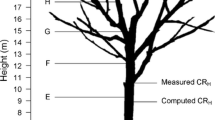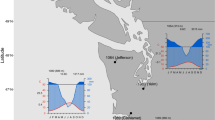Abstract
We studied correlation between crown conditions and tree-ring widths in 260 trees of pedunculate oak (Quercus robur L.) growing on 33 sites in southern Sweden. The tree-ring increment over 1998–2002 was highest in trees with healthy crowns, intermediate in trees with moderately declined crowns, and lowest in trees with heavily declining crowns. The time period with significant correlation between crown status and tree-ring increment varied between 10 years (given autocorrelation in tree-ring chronologies preserved) and 4 years (autocorrelation removed). In pairwise comparisons of three crown classes, differences in tree-ring increment between trees with healthy crowns and trees with heavily declining crowns were the most pronounced, Fisher LSD P value staying below 0.05 over 13 years (autocorrelation preserved ) or 4 years (autocorrelation removed). Over two 5-year periods (1993–1997 vs. 1998–2002) the cumulative increment increased significantly for trees with healthy crowns, did not change in trees with moderately declining crowns, and significantly decreased in trees with heavily declining crowns. For trees with healthy crowns, this dynamics may represent growth recovery after 1992 drought. Instead, oaks with defoliation above 60% appear to reach a threshold in their ability to recover growth. At sites on nutrient-poor soils cumulative increments over 1998–2002 differed significantly among trees with different crown condition and no differences were observed at sites on nutrient-rich soils. Analyses and interpretation of the oak growth trends as recovered from tree-ring chronologies may be improved by controlling for the crown status of the trees sampled, e.g., by using sampling strategy that would represent the average crown and growth conditions of the sites.
Similar content being viewed by others
References
Ahti, T., Hämet-Ahti, L., & Jalas, J. (2004). Vegetation zones and their sections in northwestern Europe. Annales Botanica Fennica, 5, 169–211.
Aniol, R. (1983). Tree-ring analysis using CATRAS. Dendrochronologia, 1, 45–53.
Berger, T. W., & Glatzel, G. (2001). Response of Quercus petraea seedlings to nitrogen fertilization. Forest Ecology Management, 149, 1–14.
Bigler, C., & Bugmann, H. (2003). Growth-dependent tree mortality models based on tree rings. Canadian Journal of Forest Research, 33, 210–221.
Bigler, C., Gricar, J., Bugmann, H., & Cufar, K. (2004). Growth patterns as indicators of impending tree death in silver fir. Forest Ecology Management, 199, 183–190.
Blaschke, H. (1994). Decline symptoms on roots of Quercus robur. European Journal of Forest Pathology, 24, 386–398.
Bridge, M. C., & Winchester, V. (2000). An evaluation of standard oak tree growth in Ruislip woods, West London. Botanical Journal of the Linean Society, 134, 61–71.
Cherubini, P., Dobbertin, M., & Innes, J. L. (1998). Potential sampling bias in long-term forest growth trends reconstructed from tree rings: A case study from the Italian Alps. Forest Ecology Management, 109, 103–118.
De Vries, W., Vel, E., Reinds, G. J., Deelstra, H., Klap, J. M., Leeters, E. E., et al. (2003). Intensive monitoring of forest ecosystems in Europe—1. Objectives, set-up and evaluation strategy. Forest Ecology Management, 174, 77–95.
DeLucia, E. H., Maherali, H., & Carey, E. V. (2000). Climate-driven changes in biomass allocation in pines. Global Change Biology, 6, 587–593.
Dickson, R. E., & Tomlinson, P. T. (1996). Oak growth, development and carbon metabolism in response to water stress. Annales des Sciences Forestieres, 53, 181–196.
Dobbertin, M. (2005). Tree growth as indicator of tree vitality and of tree reaction to environmental stress: A review. European Journal of Forest Science, 124, 319–333.
Dobbertin, M., & Brang, P. (2001). Crown defoliation improves tree mortality models. Forest Ecology Management, 141, 271–284.
Drexhage, M., Huber, F., & Colin, F. (1999). Comparison of radial increment and volume growth in stems and roots of Quercus petraea. Plant and Soil, 217, 101–110.
Duchesne, L., Ouimet, R., & Morneau, C. (2003). Assessment of sugar maple health based on basal area growth pattern. Canadian Journal of Forest Research, 33, 2074–2080.
Dwyer, J. P., Cutter, B. E., & Wetteroff, J. J. (1995). A dendrochronological study of black and scarlet oak decline in the Missouri Ozarks. Forest Ecology Management, 75, 69–75.
Eckmullner, O., & Sterba, H. (2000). Crown condition, needle mass, and sapwood area relationships of Norway spruce (Picea abies). Canadian Journal of Forest Research, 30, 1646–1654.
Elvir, J. A., Wiersma, G. B., White, A. S., & Fernandez, I. J. (2003). Effects of chronic ammonium sulfate treatment on basal area increment in red spruce and sugar maple at the Bear Brook Watershed in Maine. Canadian Journal of Forest Research, 33, 862–869.
Epron, D., & Dreyer, E. (1990). Stomatal and non stomatal limitation of photosynthesis by leaf water deficits in 3 oak species—A comparison of gas-exchange and chlorophyll a fluorescence data. Annales des Sciences Forestieres, 47, 435–450.
Fischer, R., Barbosa, P., Bastrup-Birk, A., Becher, G., Dobbertin, M., Ferretti, M., et al. (2004). The conditions of forests in Europe. 2004 Executive Report. United Nations Economic Commission for Europe. UNECE, Geneva, 52 pp.
Fritts, H. C. (1976). Tree rings and climate. London: Academic Press.
Greig, B. (1992). Occurrence of decline and dieback of oak in Great Britain. Forestry Commission Research Information Note 214. Alice Holt, Surrey: Forestry Commission
Grissino-Mayer, H. D., Holms, R. L., & Fritts, H. C. (1997). International tree-ring data bank program library manual. Tucson: Laboratory of Tree-Ring Research, University of Arizona.
Halmschlager, E., & Kowalski, T. (2004). The mycobiota in nonmycorrhizal roots of healthy and declining oaks. Canadian Journal of Botany, 82, 1446–1458.
Hartigan, J. A. (1975). Clustering algorithms. New York: Wiley.
Karlström, C. E. (1993). 1992—Torka, skyfall och rekordsnö. Väder och Vatten, SMHI 1, 2–7 (in Swedish).
Kelly, P. M., Leuschner, H. H., Briffa, K. R., & Harris, I. C. (2002). The climatic interpretation of pan-European signature years in oak ring-width series. Holocene, 12, 689–694.
Löf, M. (2001). Uthålligt skogsbruk i ädellövskog. Report 19. Uppsala: Skogsvetenskapliga fakulteten, SLU (ISSN 0283-1724; in Swedish).
Luisi, N., Lerario, P., & Vannini, A. (1993). Recent advances in studies on oak decline. Bari: Proceedings of an International Congress, Selva di Fasano (Brindisi), 13–18 September 1992.
Matzner, E., & Murach, D. (1995). Soil changes induced by air pollutant deposition and their implication for forests in Central Europe. Water Air Soil Pollution, 85, 63–76.
Neirynck, J., & Roskams, P. (1999). Relationships between crown condition of beech (Fagus sylvatica L.) and throughfall chemistry. Water, Air and Soil Pollution, 116, 389–394.
Paar, U., Korver, F., Kirchhoff, A., Gawehn, P., Schonfelder, E., & Eichhorn, J. (1999). Stabilitatsentwicklung der Eiche am Beispiel von Kronenveranderungen. Forst und Holz, 54, 227–230.
Payette, S., Fortin, M. J., & Morneau, C. (1996). The recent sugar maple decline in southern Quebec: Probable causes deduced from tree rings. Canadian Journal of Forest Research, 26, 1069–1078.
Pedersen, B. S. (1999). The mortality of midwestern overstory oaks as a bioindicator of environmental stress. Ecological Applications, 9, 1017–1027.
Pilcher, J., & Gray, S. (1982). The relationships between oak tree growth and climate in Britain. Journal of Ecology, 70, 297–304.
Raben, G., Andreae, H., & Meyer-Heisig, M. (2000). Long-term acid load and its consequences in forest ecosystems of Saxony (Germany). Water, Air and Soil Pollution, 122, 93–103.
Schweingruber, F. H. (1996). Tree rings and environment. Dendroecology (p. 609). Bern: Haupt.
Seidling, W. (2004). Crown condition within integrated evaluations of level II monitoring data at the German level. European Journal of Forest Research, 123, 63–74.
Selochnik, N. N. (1989). On the oak forest decline causes. In The state of oak forests in the forest-steppe zone (pp. 48–54). Moscow: Nauka (in Russian).
Siwecki, R., & Ufnalski, K. (1998). Review of oak stand decline with special reference to the role of drought in Poland. European Journal of Forest Pathology, 28, 99–112.
Smelko, S., & Scheer, L. (2000). Dendrochronological analysis of diameter growth and increment of pedunculate oak (Quercus robur L.) in Danube floodplain forests. Ekologia-Bratislava, 19, 125–140.
SNA (2001). Sveriges National Atlas CD-ROM. Lantmäteriverket. SNA Förlag (in Swedish).
Sokal, R. R., & Rolf, F. J. (1995). Biometry: The principles and practice of statistics in biological research. New York: Freeman.
Solberg, S., Kvindesland, S., Aamlid, D., & Venn, K. (2002). Crown condition and needle chemistry of Norway spruce in relation to critical loads of acidity in south-east Norway. Water, Air and Soil Pollution, 140, 157–171.
Sonesson, K. (1999). Oak decline in southern Sweden. Scandinavian Journal of Forest Research, 14, 368–375.
Sonesson, K. (2000). Effects of nitrogen free fertilisation in three oak stands in southern Sweden. In T. Ozsako & C. Delatour (Eds.), Recent advances on oak health in Europe. Forest Research Institute (pp. 207–216), Warsaw: Forest Research Institute (ISBN 83-87647-20-9).
Standovár, T., & Somogyi, Z. (1998). Corresponding patterns of site quality, decline and tree growth in a sessile oak stand. European Journal of Forest Pathology, 28, 133–144.
Stokes, M. A., & Smiley, T. L. (1968). An introduction to tree-ring dating. Chicago: University of Chicago Press.
Thomas, F. M., Blank, R., & Hartmann, G. (2002). Abiotic and biotic factors and their interactions as causes of oak decline in Central Europe. Forest Pathology, 32, 277–307.
Thomas, F. M., & Buttner, G. (1998). Nutrient relations in healthy and damaged stands of mature oaks on clay soils: two case studies in northwestern Germany. Forest Ecology Management, 108, 301–319.
Thomas, F. M., & Hartmann, G. (1996). Soil and tree water relations in mature oak stands of northern Germany differing in the degree of decline. Annales des Sciences Forestieres, 53, 697–720.
Thomsen, M. G., & Nellemann, C. (1994). Isolation of natural factors affecting crown density and crown color in coniferous forest—implications for monitoring of forest decline. Ambio, 23, 251–254.
Tuomenvirta, H., Drebs, A., Førland, E., Tveito, O. E., Alexandersson, H., Laursen, E. V., et al. (2001). Nordklim data set 1.0—Description and illustrations. Report no. 08/01. Oslo: Norwegian Meteorological Institute (KLIMA).
Waring, R. H. (1987). Characteristics of trees predisposed to die. BioScience, 37, 569–573.
Waring, R. H., Thies, W. G., & Muscato, D. (1980). Stem growth per unit of leaf area: A measure of tree vigor. Forest Science, 26, 112–117.
Wijk, S. (1989). Skogsskadeinventering av bok och ek 1988 i Skåne, Blekinge och Halland. Skånelänens samrådsgrupp mot skogsskador. Rep. Länsstyrelsen I Kristianstads län. Rapport, 7, 33 (in Swedish).
Zierl, B. (2002). Relations between crown condition and ozone and its dependence on environmental factors. Environmental Pollution, 119, 55–68.
Author information
Authors and Affiliations
Corresponding author
Rights and permissions
About this article
Cite this article
Drobyshev, I., Linderson, H. & Sonesson, K. Relationship Between Crown Condition and Tree Diameter Growth in Southern Swedish Oaks. Environ Monit Assess 128, 61–73 (2007). https://doi.org/10.1007/s10661-006-9415-2
Received:
Revised:
Accepted:
Published:
Issue Date:
DOI: https://doi.org/10.1007/s10661-006-9415-2




